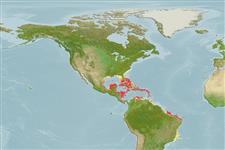>
Ophidiiformes (Cusk eels) >
Ophidiidae (Cusk-eels) > Ophidiinae
Etymology: Parophidion: Greek, para in the side of + Greek, ophidion, diminitive of ophis = serpent (Ref. 45335).
Eponymy: Karl Patterson Schmidt (1890–1957) was a herpetologist. [...] (Ref. 128868), visit book page.
Environment: milieu / climate zone / depth range / distribution range
Ecologia
marino demersale. Subtropical
Western Atlantic: Bermuda, Bahamas and southern Florida (USA) to northern South America.
Size / Peso / Age
Maturity: Lm ? range ? - ? cm
Max length : 10.0 cm TL maschio/sesso non determinato; (Ref. 7251)
Short description
Chiavi di identificazione | Morfologia | Morfometria
Scales on body in anguilloid pattern, somewhat overlapping, interorbital region scaled, opercle naked, cheeks, top of head forward to centre of interorbital region scaled; ethmoid spine reduced to a low bump; gill chamber and guts pale; no pyloric caeca; males with posterior opening on swim bladder; the two pelvic fin rays equally long or very nearly so (Ref. 34024).
Uncommon species (Ref. 34024). Adults occur in shallow coastal waters, usually in turtle grass beds (Ref. 7251). Oviparous, with oval pelagic eggs floating in a gelatinous mass (Ref. 205).
Life cycle and mating behavior
Maturità | Riproduzione | Deposizione | Uova | Fecundity | Larve
Nielsen, J.G., D.M. Cohen, D.F. Markle and C.R. Robins, 1999. Ophidiiform fishes of the world (Order Ophidiiformes). An annotated and illustrated catalogue of pearlfishes, cusk-eels, brotulas and other ophidiiform fishes known to date. FAO Fish. Synop. 125(18):178p. Rome: FAO. (Ref. 34024)
IUCN Red List Status (Ref. 130435: Version 2024-1)
Threat to humans
Harmless
Human uses
Pesca: di nessun interesse
Strumenti
Special reports
Download XML
Fonti Internet
Estimates based on models
Preferred temperature (Ref.
123201): 25.4 - 28, mean 27.2 °C (based on 214 cells).
Phylogenetic diversity index (Ref.
82804): PD
50 = 0.7500 [Uniqueness, from 0.5 = low to 2.0 = high].
Bayesian length-weight: a=0.00257 (0.00122 - 0.00544), b=3.17 (2.98 - 3.36), in cm total length, based on LWR estimates for this (Sub)family-body shape (Ref.
93245).
Trophic level (Ref.
69278): 3.4 ±0.6 se; based on size and trophs of closest relatives
Resilienza (Ref.
120179): Alto, tempo minimo di raddoppiamento della popolazione meno di 15 mesi (Preliminary K or Fecundity.).
Fishing Vulnerability (Ref.
59153): Low vulnerability (10 of 100).
